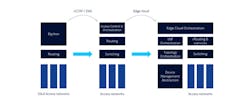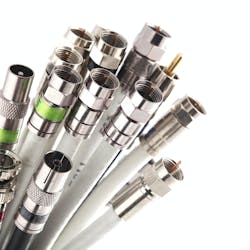Gone are the days when cable operators could focus primarily on the delivery of broadcast video. Today, broadband and IP services are their main business drivers, and this trend is certain to continue.
However, this transformation is about to become far more dramatic as the world shifts rapidly toward an enhanced, cloud-oriented communications and entertainment paradigm. This means existing IP transformation networking initiatives need to be accelerated.
Among the challenges cable operators face in this shift are requirements for evolving access networks to deliver ultra-high IP bandwidth, creating strategies for a converged edge cloud to facilitate low-latency IP services and deploying SDN control across the all-IP network.
The All-IP Consumer Experience
The ways consumers enjoy content are constantly evolving, and there are big changes on the horizon. For instance, the number of devices and surfaces on which content can be displayed is set to explode – think projector technology in homes and inside driverless vehicles. A wave of immersive content experiences is also coming, offering much higher levels of personalization, spurring further consumption of content from a vast array of sources.
Cable networks will also need to offer seemingly endless capacity, exceptional quality and imperceptible latency while leveraging the flexibility of cloud technologies in supporting this content consumption. New video formats such as 4K or 8K as well as virtual reality (VR) and augmented reality (AR) will also require large unicast data streams. New user interfaces leveraging gestures or emotional recognition will typically require single-digit-millisecond response times - a far cry from today’s networks. Future on-demand streaming will necessitate the location of high-quality content very close to end users, essentially from data centers placed at the network edge.
Through all of these changes, cable operators will eventually evolve current assets to create:
- Large scale fixed and mobile access networks that deliver ultra-high IP bandwidth. Cable will move beyond DOCSIS 3.1 and enable solutions capable of symmetrical 10 Gbps rates, while 5G will offer wireless data rates of multiple gigabits per second – made possible by reducing distances between the access nodes/cells and end users to less than a hundred meters.
- Edge clouds to deliver ultra-low latency experiences through the virtualization of network functions (VNF). Think of this as an evolution of today’s hub locations.
- Software defined network (SDN)-controlled cable transport to control the interconnectivity between external cloud, cable central datacenter and edge cloud environments.
With this broader industry view in mind, it’s important to know what can be done in the short to medium term to prepare networks for this evolution.
Transforming the Fixed Access Network
Since more IP means more DOCSIS on the coax network, operators must allocate more DOCSIS channels to free up spectrum from old analogue video channels. A move to DOCSIS 3.1 also facilitates a more efficient usage of spectrum, which results in higher IP throughput/performance.
These techniques need to be combined with architectural changes such as fiber node splitting, moving to distributed access architectures (DAA) and virtualizing Converged Cable Access Platform (CCAP) capabilities to gradually reduce the number of subscribers per coax segment.
Important considerations and migration plans include:
- Hub platforms – whereas many switched digital video (SDV) and video on demand (VOD) quadrature amplitude modulation (QAM) devices are still deployed separately from IP data QAM devices found in CCAPs.
- The need to deliver many individual IP sessions for on-demand data. This mandates node splits to reduce group size and increase available IP bandwidth, in turn requiring the supporting hub/headend expansions, which will eventually become unmanageable.
- A move to DAA alleviates this by moving some DOCSIS functionality out from the hub location to the node, a first step to virtualizing CCAP functions.
- DAA also introduces IP-based transmission via 10G Ethernet from the hub location to the fiber node for data.
- Existing SDV and VOD services still require standard analogue RF, but these can be bundled into an IP stream and transported to the node site via 10G Ethernet.
- Further improvements can be made by virtualizing other DOCSIS functions, such as control, and placing them where required in the end-to-end architecture under SDN control.
At this point, cable operators are extremely close to having an all-IP architecture.
Figure 1 shows a combination of virtualized CCAP functions and DAA running over an all-IP network built between data center, hub and node locations.
This architectural approach opens the door for access network consolidation where cable operators can deploy common control for HFC, PON, IP/MPLS and wireless access across an end-to-end, SDN-controlled cable network. It also reduces floor space and power requirements in the hub, facilitating consolidation and the creation of future edge cloud domains.
A Cable Edge Cloud
In the future, hub locations will effectively migrate to be distributed datacenters – edge clouds – from which cable operators can serve up communications and entertainment experiences with the needed quality. This would be a two-step process.
As described above, today’s siloed access architectures - such as HFC, PON and Ethernet - will be unified under a common, virtualized access control and orchestration layer, with functions present in the hub or in a central data center, lowering CAPEX and OPEX for future multi-access roll outs.
With the migration to an edge cloud, the hub control and orchestration will be decomposed into VNF orchestration and topology orchestration components. Physical network functions, such as service routing and access device management, will be virtualized.
Figure 2: a two-step migration to a cable edge cloud.
Typical services that will run in the edge cloud could include virtual customer premises equipment (CPE), virtualized content delivery network (CDN) and multi-access edge computing. These will effectively be distributed datacenters requiring communication with the cable operators’ existing central datacenter, which typically will house common services.
SDN-Controlled Cable Networks
Finally, carrier SDN techniques will be leveraged across the cable network to:
- Correctly dimension network capacity between central datacenters and cable edge clouds
- Control IP network-embedded quality capabilities, such as performance analytics and security monitoring
- Liaise with SD-WAN controllers for offnet services
As new consumption trends take hold, service providers will be able to leverage IP and cloud networking technologies to deliver enhanced experiences via new business models.
Cable operators will be well-positioned as they accelerate their IP transformation programs, evolve their cable access for multi-technology ultra-high-speed data, evolve their hubs into edge clouds and leverage flexible SDN control across their evolved cable networks.
Steve Davidson is the European marketing director for cable at Nokia.







